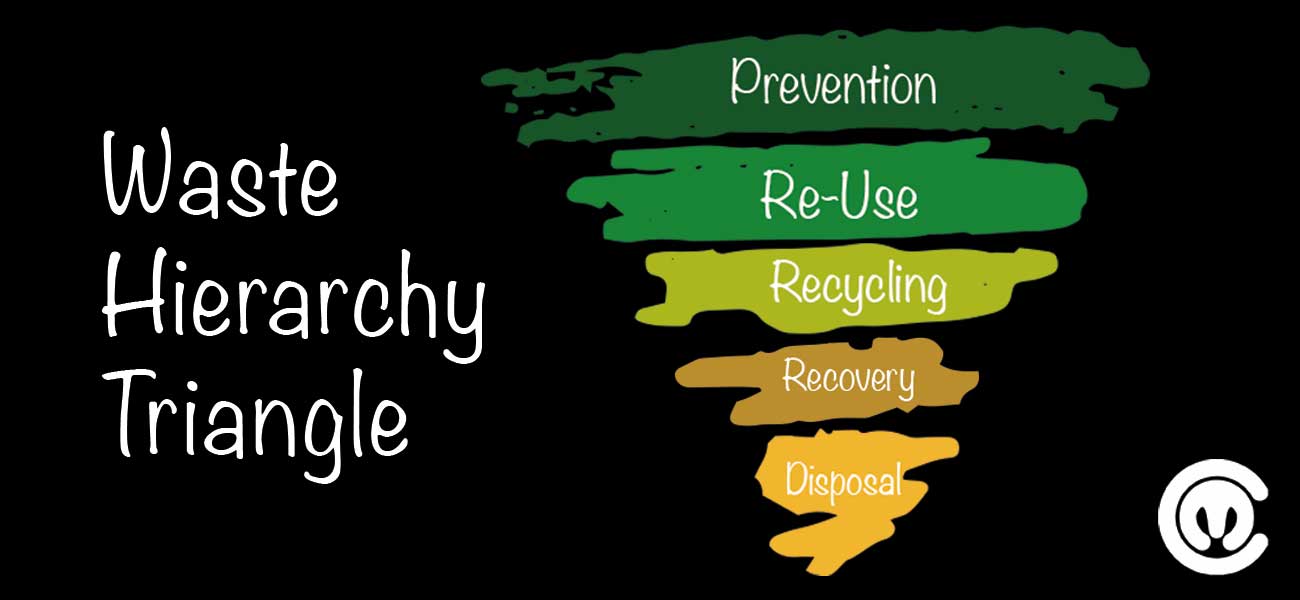
03 Dec The Waste Hierarchy: Re-Use, Recycle, Recover
As we move away from a world of excessive consumerism and towards one that is more concerned with preservation, the way we handle waste is being closely scrutinised. Businesses are coming under more and more pressure to reduce the amount of waste they produce, and explore alternative options like reuse and recycling to protect the environment. As a business, you should care about the impact you’re having on the environment. But you should also care about your bottom line – and waste has a place here too. Every day businesses across the UK are throwing away products due to the waste they produce, often unnecessarily. To change this, you need to look at adopting something called the waste hierarchy, which not only reduces the amount your business spends on waste, but keeps your business green.
What Is The Waste Hierarchy?
Put simply, the waste hierarchy is a way of ensuring businesses are protecting the environment and acting in a responsible manner when it comes to the waste they produce. It forms a pyramid on its head, with prevention sitting at the top as the most preferred option, and disposal sitting at the bottom as the least favoured option. The idea is that business should be taking action on waste from the top down in this fashion to minimise their impact on the environment and protect resource and energy consumption. The hierarchy itself looks like this:
Prevention: Using less material in design and manufacture. This means keeping products for longer, and reusing products and equipment where possible. It also means using less hazardous materials where you can.
Re-Use: Checking, cleaning, repairing, refurbishing, whole items or spare parts, preferably avoiding any other pre—processing. Reuse here means using a substance, product or material again before it becomes waste.
Recycling: Turning waste into a new substance or product, therefore reducing the amount of new materials needed.
Recovery: Includes anaerobic digestion, incineration with energy recovery, gasification and pyrolysis which produce energy (fuels, heat and power), and materials from waste. Disposal: Landfill and incineration without energy recovery.
Disposal: Landfill and incineration without energy recovery.
If done properly, following the hierarchy of waste can have a lot of positive benefits for businesses and the environment. For example, it can help to:
- Prevent harmful greenhouse gas emissions
- Save energy
- Reduce pollutants
- Conserve valuable resources
- Create jobs
- Stimulate the development of more green technologies
Putting It Into Practice
All of that is well and good, but what does it actually mean for businesses who are trying to put it into place? How can you ensure you’re following the hierarchy properly and doing everything you can do to preserve the environment and minimise your impact? After all, even if you didn’t want to do it, the Waste Hierarchy is part of UK environmental law, so businesses have to follow it. And if you want to put it into really simple terms, that means you need to take measures to prevent waste, and apply the hierarchy to any waste you do create.
The government has published some guidance that suggests asking yourself 6 critical questions, and building your waste management plan around the answers:
1. What type of waste does your business create?
2. Is your business dealing with waste in the best environmental way?
3. Could your business send more waste to a business which can repair it/refurbish it/clean it so that it can be eventually reused?
4. Could your business recycle more waste materials? (E.g. by sorting it better)
5. Could any food or garden waste your business handles be used for AD?
6. If no, can it be composted?
At Charterhouse Müller we are proud to be a part of this hierarchy. We priorities refurbishment and reuse of all forms of IT and computer equipment, making it easier than ever for business to meet their obligations under the hierarchy. Our experts can help with the reuse and a last resort recycling and recovery of old technology, helping business reduce waste in the first place. If you would like to know more, just get in touch with the team today for more information.


